
Vincent van Gogh Painting Reproductions 15 of 18
1853-1890
Dutch Post-Impressionist Painter
Vincent Van Gogh, Dutch painter (Groot Zundert, Brabant, 1853-Auvers-sur-Oise 1890).
Vincent Van Gogh embodied the myth of the misunderstood genius of his time, so much so that his works were ignored in his own time and are today among the most sought-after in the world. He tried to exorcise his inner turmoil through painting. His research into form and color had a lasting influence on the avant-gardes to come.
A pastor's son, Vincent Van Gogh was named after a brother who was stillborn the year before he was born. Four years after his birth, he had another brother, Theodorus (1857-1891), whom he called Theo - and who supported him morally and financially throughout his life.
An unstable child with a talent for drawing, Vincent's uncles included the founder of the Goupil art gallery in Paris, which had numerous branches throughout Europe. He was sent successively to the Hague branch (1869), then to the Brussels and London branches (1873-1876), to learn the art business. Following setbacks in love, he took refuge in mysticism, writing letters to Theo as an outlet for his troubled soul.
After a brief stay in Paris, Van Gogh returned to London and became a schoolteacher in the working-class district of Isleworth. He sensed a true religious vocation, which led him to evangelize the miners of the Borinage region in Belgium. His zeal for evangelism offended the ecclesiastical authorities, who put a stop to it after a year (1879). After several years of solitary wandering, painting took precedence over preaching.
A devotee of Jean-François Millet, Van Gogh devoted himself to the study of landscapes and peasant scenes when he took up oil painting in 1882, on the advice of his cousin by marriage, Anton Mauve (1838-1888).
In Nuenen, near Eindhoven, where he lived for almost two years (December 1883-November 1885), he became familiar with Dutch realism (Potato Eaters, 1885). He then moved to Antwerp to attend the École des Beaux-Arts, where he discovered the work of Peter Paul Rubens. But, put off by the teaching he received, he left again in February 1886 to join his brother in Paris, who took him in at a studio in Montmartre.
Van Gogh frequented the milieu of Impressionist and Neo-Impressionist painters (Camille Pissarro, Paul Gauguin, Paul Signac). He joined the studio of Cormon (1845-1924), where he became friends with Émile Bernard and Henri de Toulouse-Lautrec, who were to exert a clear influence on him. The three friends organized their first exhibition in 1887. They didn't sell any paintings, but they knew that their time had not yet come.
In contact with Gauguin, but also under the influence of Japanese prints, Van Gogh refined his research into color; his palette became lighter and more diversified, his style more flexible, giving rise to experiments in still lifes, landscapes and portraits (Père Tanguy, 1887). To perfect his work, he needed to find skies other than those of Paris. So, in February 1888, he moved to Arles. Dazzled by the light of the Midi, Van Gogh made color the very object of his work, rather than just a component of it. He sought the greatest possible intensity in both tones (such as the yellows in the Sunflower series) and chromatic relationships (yellow/blue, yellow/green, blue/green, red/green): flowers (Peach in bloom, "Souvenir de Mauve", 1888), landscapes (the Crau Plain with the ruins of Montmajour), interiors (the Night Café), portraits (Mousmée in the armchair) are charged with great expressivity.
Living alone among the people of Arles, who were suspicious of this strange outsider, Van Gogh sank into depression. Yet he did not abandon his dream of forming a community of painters. He finally persuaded Gauguin to join him. The master of Pont-Aven arrived in Arles in November 1888 and took up residence in the "Yellow House" - his host's studio.
But he couldn't stand Gauguin's inexpressive nature, and on the evening of December 23, 1888, after a more violent argument than the previous ones, he left for the house. Shortly afterwards, Van Gogh took a knife and cut off part of his left ear, which he then took to a prostitute. Two self-portraits bear witness to this gesture.
Admitted to the Saint-Rémy-de-Provence asylum, where he remained for a year (May 1889-May 1890), Van Gogh devoted himself to a style of painting in which elongated brushstrokes and twisted forms convey the force of his torments (Starry night, 1889). As soon as he was discharged, he had to leave Arles under pressure from the locals, whom he frightened.
Terribly weakened, Van Gogh agreed to go to Auvers-sur-Oise, where Dr. Paul Gachet lived. A doctor, but also an art lover and himself a painter in his spare time, Gachet was a friend of Paul Cézanne, Édouard Manet, Auguste Renoir and Edgar Degas. Through Théo Van Gogh, he became aware of Vincent's work, the importance of which he immediately sensed, at the same time as his illness. From then on, he never stopped trying to get him to come to Auvers-sur-Oise, drawing criticism - unfounded at the time - from those who accused him of acting out of self-interest.
A real friendship developed between the two men. Gachet succeeded in establishing a climate of trust around Van Gogh, which had a beneficial effect. The painter painted a first portrait of his benefactor, who, filled with admiration, commissioned a second. Perhaps for the first time in his life, Van Gogh was aware that his talent was recognized and his art understood by a man of quality.
Picking up his brushes again, he spent whole days at his easel, executing several of his masterpieces: "The Church of Auvers-sur-Oise", "View from the bedside" (1890), "Cottages at Cordeville", "Wheatfield with Crows". Here again, color is crucial, but it becomes darker, and forms more tortured, like the painter's mind. His inner pain is the strongest: "There's something inside me: what is it?" he desperately wants to know. He only benefited from the help Gachet was able to give him for three months, and ended up quarrelling with Gachet as well.
On July 27, 1890, while out for a walk, Van Gogh shot himself in the chest and, despite Gachet's care, died two days later. This was the end of an artist who had signed over eight hundred canvases, but who, during his lifetime, sold only one, the "The Red Vineyard", bought in Brussels in 1890.
Vincent Van Gogh embodied the myth of the misunderstood genius of his time, so much so that his works were ignored in his own time and are today among the most sought-after in the world. He tried to exorcise his inner turmoil through painting. His research into form and color had a lasting influence on the avant-gardes to come.
A pastor's son, Vincent Van Gogh was named after a brother who was stillborn the year before he was born. Four years after his birth, he had another brother, Theodorus (1857-1891), whom he called Theo - and who supported him morally and financially throughout his life.
An unstable child with a talent for drawing, Vincent's uncles included the founder of the Goupil art gallery in Paris, which had numerous branches throughout Europe. He was sent successively to the Hague branch (1869), then to the Brussels and London branches (1873-1876), to learn the art business. Following setbacks in love, he took refuge in mysticism, writing letters to Theo as an outlet for his troubled soul.
After a brief stay in Paris, Van Gogh returned to London and became a schoolteacher in the working-class district of Isleworth. He sensed a true religious vocation, which led him to evangelize the miners of the Borinage region in Belgium. His zeal for evangelism offended the ecclesiastical authorities, who put a stop to it after a year (1879). After several years of solitary wandering, painting took precedence over preaching.
A devotee of Jean-François Millet, Van Gogh devoted himself to the study of landscapes and peasant scenes when he took up oil painting in 1882, on the advice of his cousin by marriage, Anton Mauve (1838-1888).
In Nuenen, near Eindhoven, where he lived for almost two years (December 1883-November 1885), he became familiar with Dutch realism (Potato Eaters, 1885). He then moved to Antwerp to attend the École des Beaux-Arts, where he discovered the work of Peter Paul Rubens. But, put off by the teaching he received, he left again in February 1886 to join his brother in Paris, who took him in at a studio in Montmartre.
Van Gogh frequented the milieu of Impressionist and Neo-Impressionist painters (Camille Pissarro, Paul Gauguin, Paul Signac). He joined the studio of Cormon (1845-1924), where he became friends with Émile Bernard and Henri de Toulouse-Lautrec, who were to exert a clear influence on him. The three friends organized their first exhibition in 1887. They didn't sell any paintings, but they knew that their time had not yet come.
In contact with Gauguin, but also under the influence of Japanese prints, Van Gogh refined his research into color; his palette became lighter and more diversified, his style more flexible, giving rise to experiments in still lifes, landscapes and portraits (Père Tanguy, 1887). To perfect his work, he needed to find skies other than those of Paris. So, in February 1888, he moved to Arles. Dazzled by the light of the Midi, Van Gogh made color the very object of his work, rather than just a component of it. He sought the greatest possible intensity in both tones (such as the yellows in the Sunflower series) and chromatic relationships (yellow/blue, yellow/green, blue/green, red/green): flowers (Peach in bloom, "Souvenir de Mauve", 1888), landscapes (the Crau Plain with the ruins of Montmajour), interiors (the Night Café), portraits (Mousmée in the armchair) are charged with great expressivity.
Living alone among the people of Arles, who were suspicious of this strange outsider, Van Gogh sank into depression. Yet he did not abandon his dream of forming a community of painters. He finally persuaded Gauguin to join him. The master of Pont-Aven arrived in Arles in November 1888 and took up residence in the "Yellow House" - his host's studio.
But he couldn't stand Gauguin's inexpressive nature, and on the evening of December 23, 1888, after a more violent argument than the previous ones, he left for the house. Shortly afterwards, Van Gogh took a knife and cut off part of his left ear, which he then took to a prostitute. Two self-portraits bear witness to this gesture.
Admitted to the Saint-Rémy-de-Provence asylum, where he remained for a year (May 1889-May 1890), Van Gogh devoted himself to a style of painting in which elongated brushstrokes and twisted forms convey the force of his torments (Starry night, 1889). As soon as he was discharged, he had to leave Arles under pressure from the locals, whom he frightened.
Terribly weakened, Van Gogh agreed to go to Auvers-sur-Oise, where Dr. Paul Gachet lived. A doctor, but also an art lover and himself a painter in his spare time, Gachet was a friend of Paul Cézanne, Édouard Manet, Auguste Renoir and Edgar Degas. Through Théo Van Gogh, he became aware of Vincent's work, the importance of which he immediately sensed, at the same time as his illness. From then on, he never stopped trying to get him to come to Auvers-sur-Oise, drawing criticism - unfounded at the time - from those who accused him of acting out of self-interest.
A real friendship developed between the two men. Gachet succeeded in establishing a climate of trust around Van Gogh, which had a beneficial effect. The painter painted a first portrait of his benefactor, who, filled with admiration, commissioned a second. Perhaps for the first time in his life, Van Gogh was aware that his talent was recognized and his art understood by a man of quality.
Picking up his brushes again, he spent whole days at his easel, executing several of his masterpieces: "The Church of Auvers-sur-Oise", "View from the bedside" (1890), "Cottages at Cordeville", "Wheatfield with Crows". Here again, color is crucial, but it becomes darker, and forms more tortured, like the painter's mind. His inner pain is the strongest: "There's something inside me: what is it?" he desperately wants to know. He only benefited from the help Gachet was able to give him for three months, and ended up quarrelling with Gachet as well.
On July 27, 1890, while out for a walk, Van Gogh shot himself in the chest and, despite Gachet's care, died two days later. This was the end of an artist who had signed over eight hundred canvases, but who, during his lifetime, sold only one, the "The Red Vineyard", bought in Brussels in 1890.
415 Vincent van Gogh Paintings
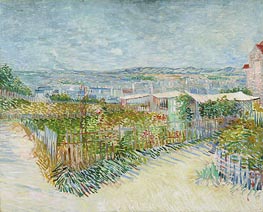
Montmartre: Behind the Moulin de la Galette 1887
Oil Painting
$563
$563
Canvas Print
$60.73
$60.73
SKU: VVG-12802
Vincent van Gogh
Original Size: 81 x 100 cm
Van Gogh Museum, Amsterdam, Netherlands
Vincent van Gogh
Original Size: 81 x 100 cm
Van Gogh Museum, Amsterdam, Netherlands
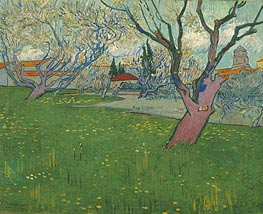
Orchards in Blossom, View of Arles 1889
Oil Painting
$541
$541
Canvas Print
$61.43
$61.43
SKU: VVG-12803
Vincent van Gogh
Original Size: 50 x 65 cm
Van Gogh Museum, Amsterdam, Netherlands
Vincent van Gogh
Original Size: 50 x 65 cm
Van Gogh Museum, Amsterdam, Netherlands
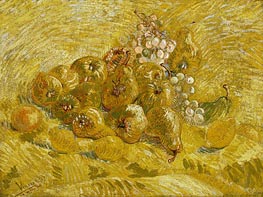
Quinces, Lemons, Pears and Grapes 1887
Oil Painting
$526
$526
Canvas Print
$56.05
$56.05
SKU: VVG-12804
Vincent van Gogh
Original Size: 48.5 x 65 cm
Van Gogh Museum, Amsterdam, Netherlands
Vincent van Gogh
Original Size: 48.5 x 65 cm
Van Gogh Museum, Amsterdam, Netherlands
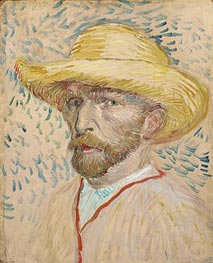
Self Portrait 1887
Oil Painting
$436
$436
Canvas Print
$49.98
$49.98
SKU: VVG-12805
Vincent van Gogh
Original Size: 40.8 x 32.9 cm
Van Gogh Museum, Amsterdam, Netherlands
Vincent van Gogh
Original Size: 40.8 x 32.9 cm
Van Gogh Museum, Amsterdam, Netherlands

Window in the Studio 1889
Oil Painting
$465
$465
Canvas Print
$58.12
$58.12
SKU: VVG-12806
Vincent van Gogh
Original Size: 62 x 47 cm
Van Gogh Museum, Amsterdam, Netherlands
Vincent van Gogh
Original Size: 62 x 47 cm
Van Gogh Museum, Amsterdam, Netherlands
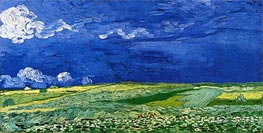
Wheatfields under Thunderclouds 1890
Oil Painting
$580
$580
Canvas Print
$49.98
$49.98
SKU: VVG-12807
Vincent van Gogh
Original Size: 50 x 100.5 cm
Van Gogh Museum, Amsterdam, Netherlands
Vincent van Gogh
Original Size: 50 x 100.5 cm
Van Gogh Museum, Amsterdam, Netherlands
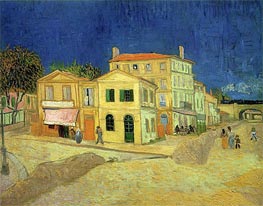
The Yellow House 1888
Oil Painting
$662
$662
Canvas Print
$58.67
$58.67
SKU: VVG-12808
Vincent van Gogh
Original Size: 72 x 91.5 cm
Van Gogh Museum, Amsterdam, Netherlands
Vincent van Gogh
Original Size: 72 x 91.5 cm
Van Gogh Museum, Amsterdam, Netherlands

The Potato Eaters 1885
Oil Painting
$976
$976
Canvas Print
$53.57
$53.57
SKU: VVG-12814
Vincent van Gogh
Original Size: 82 x 114 cm
Van Gogh Museum, Amsterdam, Netherlands
Vincent van Gogh
Original Size: 82 x 114 cm
Van Gogh Museum, Amsterdam, Netherlands

Self Portrait with Felt Hat 1888
Oil Painting
$518
$518
Canvas Print
$49.98
$49.98
SKU: VVG-12815
Vincent van Gogh
Original Size: 44 x 37.5 cm
Van Gogh Museum, Amsterdam, Netherlands
Vincent van Gogh
Original Size: 44 x 37.5 cm
Van Gogh Museum, Amsterdam, Netherlands
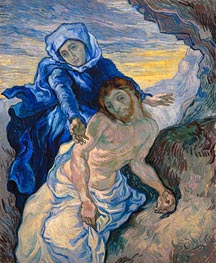
Pieta (after Delacroix) 1889
Oil Painting
$620
$620
Canvas Print
$62.11
$62.11
SKU: VVG-12816
Vincent van Gogh
Original Size: 73 x 60.5 cm
Van Gogh Museum, Amsterdam, Netherlands
Vincent van Gogh
Original Size: 73 x 60.5 cm
Van Gogh Museum, Amsterdam, Netherlands
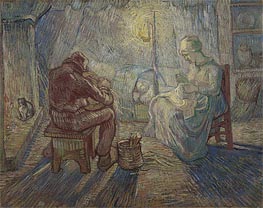
Night (after Millet) 1889
Oil Painting
$663
$663
Canvas Print
$61.98
$61.98
SKU: VVG-12817
Vincent van Gogh
Original Size: 74.5 x 93.5 cm
Van Gogh Museum, Amsterdam, Netherlands
Vincent van Gogh
Original Size: 74.5 x 93.5 cm
Van Gogh Museum, Amsterdam, Netherlands

Landscape at Twilight 1890
Oil Painting
$616
$616
Canvas Print
$49.98
$49.98
SKU: VVG-12818
Vincent van Gogh
Original Size: 50 x 101 cm
Van Gogh Museum, Amsterdam, Netherlands
Vincent van Gogh
Original Size: 50 x 101 cm
Van Gogh Museum, Amsterdam, Netherlands
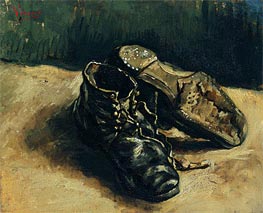
A Pair of Shoes 1886
Oil Painting
$378
$378
Canvas Print
$49.98
$49.98
SKU: VVG-12823
Vincent van Gogh
Original Size: 37.5 x 46 cm
Private Collection
Vincent van Gogh
Original Size: 37.5 x 46 cm
Private Collection

L'Arlesienne (Madame Ginoux) 1890
Oil Painting
$515
$515
Canvas Print
$53.38
$53.38
SKU: VVG-12824
Vincent van Gogh
Original Size: 60 x 50 cm
Galleria Nazionale d'Arte Moderna, Rome, Italy
Vincent van Gogh
Original Size: 60 x 50 cm
Galleria Nazionale d'Arte Moderna, Rome, Italy
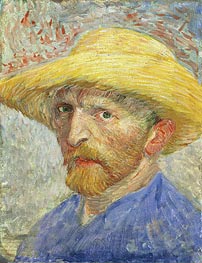
Self Portrait 1887
Oil Painting
$426
$426
Canvas Print
$49.98
$49.98
SKU: VVG-12825
Vincent van Gogh
Original Size: 34 x 26.7 cm
Detroit Institute of Arts, Michigan, USA
Vincent van Gogh
Original Size: 34 x 26.7 cm
Detroit Institute of Arts, Michigan, USA
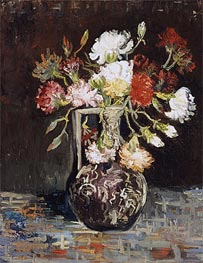
Bouquet of Flowers 1886
Oil Painting
$400
$400
Canvas Print
$49.98
$49.98
SKU: VVG-12826
Vincent van Gogh
Original Size: unknown
Private Collection
Vincent van Gogh
Original Size: unknown
Private Collection
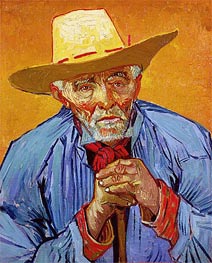
Portrait of Patience Escalier 1888
Oil Painting
$614
$614
Canvas Print
$52.36
$52.36
SKU: VVG-12827
Vincent van Gogh
Original Size: 69.2 x 56 cm
Private Collection
Vincent van Gogh
Original Size: 69.2 x 56 cm
Private Collection
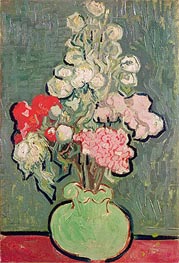
Bouquet of Flowers 1890
Oil Painting
$373
$373
Canvas Print
$49.98
$49.98
SKU: VVG-12828
Vincent van Gogh
Original Size: 42 x 29 cm
Van Gogh Museum, Amsterdam, Netherlands
Vincent van Gogh
Original Size: 42 x 29 cm
Van Gogh Museum, Amsterdam, Netherlands

White House at Night 1890
Oil Painting
$556
$556
Canvas Print
$54.02
$54.02
SKU: VVG-12829
Vincent van Gogh
Original Size: 59 x 72.5 cm
The State Hermitage Museum, St. Petersburg, Russia
Vincent van Gogh
Original Size: 59 x 72.5 cm
The State Hermitage Museum, St. Petersburg, Russia
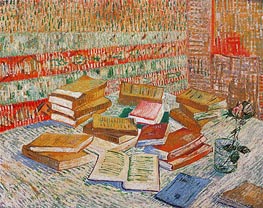
The Yellow Books (Parisian Novels) 1887
Oil Painting
$661
$661
Canvas Print
$58.94
$58.94
SKU: VVG-12830
Vincent van Gogh
Original Size: 73 x 92 cm
Private Collection
Vincent van Gogh
Original Size: 73 x 92 cm
Private Collection
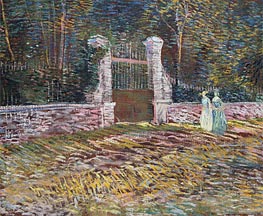
Entrance to the Voyer-d'Argenson Park at Asnieres 1887
Oil Painting
$549
$549
Canvas Print
$53.51
$53.51
SKU: VVG-12831
Vincent van Gogh
Original Size: 54.6 x 66.7 cm
Private Collection
Vincent van Gogh
Original Size: 54.6 x 66.7 cm
Private Collection
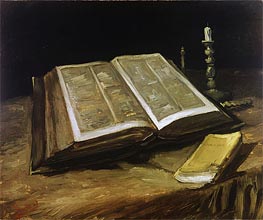
Still Life with Bible 1885
Oil Painting
$476
$476
Canvas Print
$62.66
$62.66
SKU: VVG-12832
Vincent van Gogh
Original Size: 65.7 x 78.5 cm
Van Gogh Museum, Amsterdam, Netherlands
Vincent van Gogh
Original Size: 65.7 x 78.5 cm
Van Gogh Museum, Amsterdam, Netherlands

Postman Joseph Roulin 1888
Oil Painting
$620
$620
Canvas Print
$60.32
$60.32
SKU: VVG-12833
Vincent van Gogh
Original Size: 81.3 x 65.4 cm
Boston Museum of Fine Arts, Massachusetts, USA
Vincent van Gogh
Original Size: 81.3 x 65.4 cm
Boston Museum of Fine Arts, Massachusetts, USA
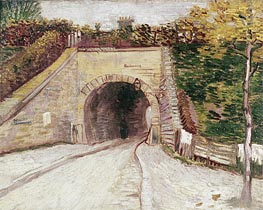
Roadway wtih Underpass (Tunnel through Hillside) 1887
Oil Painting
$388
$388
Canvas Print
$49.98
$49.98
SKU: VVG-12834
Vincent van Gogh
Original Size: 31.5 x 40.5 cm
Solomon R. Guggenheim Museum, New York, USA
Vincent van Gogh
Original Size: 31.5 x 40.5 cm
Solomon R. Guggenheim Museum, New York, USA